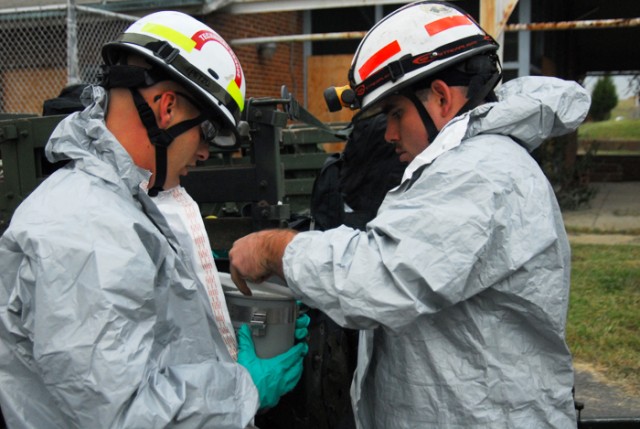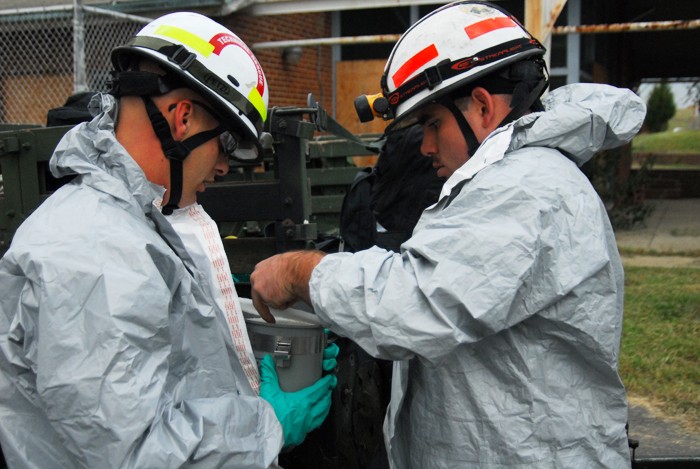
By Tom Mani JFHQ-NCR/MDW
Public Affairs
Joint Force Headquarters National Capital Region sees the exercises as vital to being able to fulfill its mission. From the chaos of derelict buildings and a weed-infested campus near a Northern Virginia landfill, order and cohesion must arise.
Lessons must be passed on and new personnel trained in the language of disaster response. Planning moves to execution, logistics and techniques, something old, something new.
"This is where I want to be," Corey Wright declares. "The planning is hard work and takes all year. This," the former District of Columbia youth correctional facility, "is where it comes together."
Wright, a veteran planner in the JFHQ-NCR J37 shop, has been called "a linchpin" in bringing a score of agencies together for Capital Shield 10.
There have been five Capital Shield exercises since 2004. Not many of those taking part this week were there for Capital Shield 06.
But the exercises have built on each other.
"That part over there is new this year," Alexandria Fire Department Lt. David Bogozi said pointing to an elevated section of framing, part of the warren of framed tunneling extending haphazardly through what might have been a gymnasium or cafeteria for youth incarcerated at the former detention facility.
Inside the boxy tunnels, members of the 911th Technical Rescue Engineer Company stretch forward on their bellies or on their backs to get a chisel, a saw, a drill to whatever is keeping them back from exploring the tunnel to the end and getting to whoever may be trapped behind all the debris.
This year, the collapsed structure is the parking garage for the Pentagon City Mall, collapsed in upon the mall and the Metrorail line and station beneath. A global summit is taking place in Baltimore and multiple garbage trucks were stolen, some packed with explosives and exploded as part of a terrorist attack on the United States. There are numerous injuries and fatalities.
"This is an important exercise," Brig. Gen. Karl R. Horst told a group of executive observers at Fort Myer before busing them to the exercise site for a tour Wednesday (Oct. 14, 2009), the second day of the three-day FTX. "The emphasis is on Defense Support to Civil Authorities, as it always is in the interagency."
"We will validate our interoperability."
The exercise gives Joint Force Headquarters National Capital Region the best opportunity to stress test the 911th TREC, an asset that can deploy an advance team, by air if needed, in a matter of hours to aid in a recovery mission, as they did when the Pentagon was attacked in 2001.
A larger group follows with a convoy of specialized vehicles that stretches a half-mile long, falling in to provide a minimum of 72 hours of self-supported recovery capability for the incident commander.
Horst underscored the "absolutely unique" nature of the engineer company as Col. Jeryl C. Ludowese, commander of the Army Air Operations Group explained her engineers' responsibilities to stabilize and breach structures that otherwise they might have had a hand in building.
Ludowese said that those new to the company require a year to acquire the special skills demanded of them. Save for combat lifesaving and slingload and air assault training, the unit must look outside the Army to round them out. Every Soldier gets a basic technical rescue course, what might be considered "Rescue AIT," Ludowese quipped. They also train for HAZMAT awareness and operations, trench rescue and combat lifesaving.
Two in each rescue squad are further trained to emergency medical technician standards, and selected Soldiers become HAZMAT technicians. Each year 15 are trained at the Colorado School of Mines in mine rescue operations, becoming expert in various breathing apparatus operations. Leaders all cover down on Federal Emergency Management National Response Framework, Incident Command Systems, and National Incident Management System courses.
One Soldier in each platoon is trained as a structural specialist through FEMA and the Corps of Engineers. "We also have reached back to the Corps of Engineers' specialists," Ludowese said. The "tele-engineering" may give responders detailed information on the way a partly collapsed building may need to be approached, details on loads, construction methods and the like.
At the site, the 911th becomes part of the total effort, although their line of attack is paralleled by a team from Arlington County entering from the opposite side. Another -- is it Fairfax County, Quantico, Loudoun County' -- enters through the roof.
Confusing to a casual observer, the command structure has the participants assigned to sectors and teams, time on and time off, all reporting back progress and events, the latter assured through exercise injects.
A medical evacuation mission brings together air crews from the D.C. National Guard, flying personnel who may have been treated first by the tunnelers, or by volunteers from the Fairfax or Montgomery County Civilian Emergency Response Teams. There Huey and Lakota fly from a field at the south end of the campus. Earlier sorties by the Black Hawks of the 12th Aviation Battalion had brought the 911th's Initial Response Team.
National Capital Region Medical Joint Task Force - JTF CAPMED - works in an operating room on state-of-the-art medical mannequins developed by PEO Simulation, Training and Instrumentation.
Mark Tuttle, with the PEO-STRI, sits in a corner of the tent in front of computer screens tapping in information and calling out vital signs and other readings to the team that Capt. Sharon Frattalone, a Walter Reed internal medicine MD is directing, trying to restart the patient's heart.
Another mannequin, a stake through its chest, is nearby, but a member of the medical team reports "We haven't lost a patient today."
A trauma and life support bus belonging to Walter Reed sits nearby, empty but waiting.
JFHQ-NCR's own Mobile Command Center is there with the other vehicles that make up the Commander's Assessment Team. The MCC remotely links the headquarters element - at Fort McNair or at an alternate site - and every other interagency element in the National Capital Region, which ensures that it stays "wired together" through regular communications drills and response-vehicle rallies.
And this year, more public attention than in prior years:
Capt. Robert Crowe, commander of the 911th, praised both the exercise and the facility in talking with Fox 5 news reporter Holly Morris. "It provides a great realism that we couldn't replicate anywhere else.
"The exercise, continuing through rain on day three has an end in sight. When the final recovery is made, probably around 5 p.m., the last personnel will leave.
No one can predict the next catastrophe, let alone its length. JFHQ-NCR spokesperson Tim Nosal, speaking to the same reporter near a fire lit to warm the responders, summed up the reason for training together.
"If the event ever happens, we can be there; we can respond on time, we can save lives."

Social Sharing